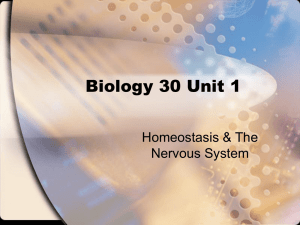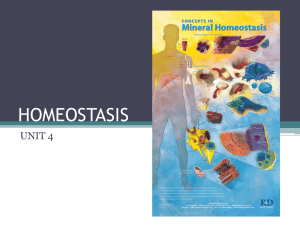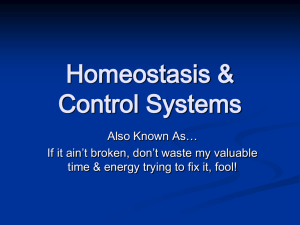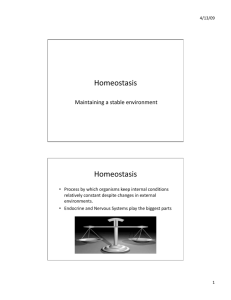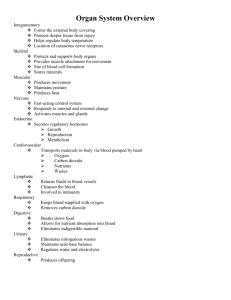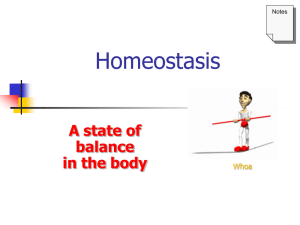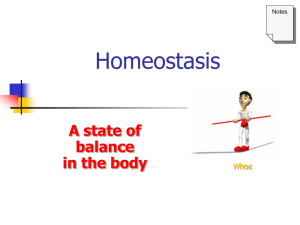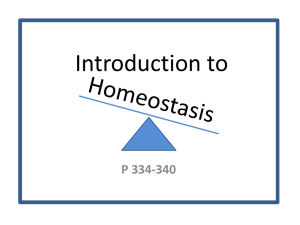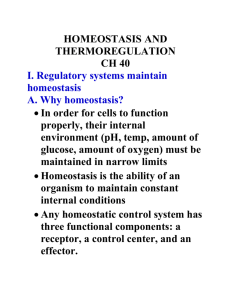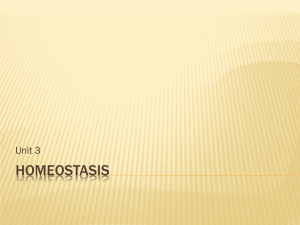HOMEOSTASIS
advertisement
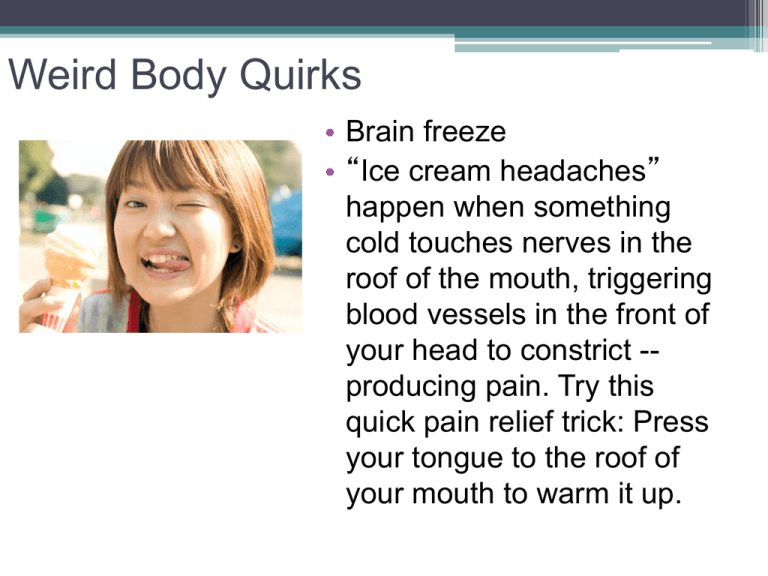
Weird Body Quirks • Brain freeze • “Ice cream headaches” happen when something cold touches nerves in the roof of the mouth, triggering blood vessels in the front of your head to constrict -producing pain. Try this quick pain relief trick: Press your tongue to the roof of your mouth to warm it up. HOMEOSTASIS & Control Systems UNIT 4 Also Known As… If it ain’t broken, don’t waste my valuable time & energy trying to fix it, fool! Learning goals . . . • To explain the process of maintaining homeostasis through feedback loops and their components. You will show your understanding by . . . • Presenting an explanation (diagramatic, written or kinesthetic) of thermoregulation What happens in your body when you do a Triathalon? • Cell Resp increases • Body Temp increases to 39 degrees Celsius (due to heat from CR rxns) • Sweat is produced to dissipate heat • This loss of water, drops blood pressure • Heart responds, Kidneys conserve water • Electrolytes (salts) are lost in sweat • Body must use hormones to keep a steady supply of glucose to CR pathways • Nervous systems monitors o2 levels, increasing breathing rate if necessary • Nervous systems also work with the circulatory system to divert blood to essential areas (muscles, brain, heart…away from stomach etc) 4km swim, 180km bike, 42km run! The “Ideal Body State” • • • • • 37 degrees 0.1% blood sugar Blood pH 7.35 Environment doesn’t always allow for this! Organs and body systems are constantly adapting Homeostasis • Maintenance of a relatively stable internal, fluid environment (internal milieu) despite a changing external environment • Homios = Similar Stasis = Standing Still Temperature 37oC (98.6oF) Blood pH 7.35 Blood sugar level 0.1% • http://www.lionden.com/homeostasis.htm Homeostasis All of our organ systems work together to maintain Homeostasis Homeostasis is a steady internal state, keeps conditions in the body constant. Examples: 1. Blood Pressure (circulatory system) 2. Respiration Rate (respiratory system) 3. Body Temperature (circulatory system) 4. Blood Sugar (digestive and circulatory) The brain and the adrenal system (hormones) do most of the regulating. Homeostatic Control Mechanisms 1. Monitors ▫ ▫ Senses state of system (Brain stem receptors detect increased CO2 in the blood) 2. Coordinating Centre ▫ ▫ Receives incoming info about system and decides what the next steps should be (Nerve cells in brain receive and send a signal to the diapragm) 3. Regulator ▫ ▫ Carries out the appropriate next step to keep system at homeostasis (Diaphragm increases depth and rate of breathing) Homeostatic Control System Stimulus Deviation from set point Response Move system towards set point Effector Causes changes to compensate for deviation Negative feedback (-) Sensor Constantly monitors conditions Integrating Centre Compares conditions to a set point based on a desired value Dynamic Equilibrium • There will always be fluctuations in levels • Homeostatic mechanisms ensure that all body systems function within an acceptable range. • Mammalian Diving Reflex • Check out the ICEMAN! • http://www.youtube.com/watch?v=madoDvtKE es • Homework…Read p344-347 (Feedback) • Do Q 2, 3, 4, 9, 10 p348 Feedback Mechanisms/Loops • Positive feedback - a mechanism by which an output is enhanced ▫ Contractions in childbirth: contractions stimulate oxytocin which stimulates more muscle contractions Negative feedback - a mechanism by which an output is diminished Any change from normal range of function is resisted in negative feedback. The change initiates responses that bring the function of the organ back to its normal range. Negative feedback loops require a Receptor, A Control Center, and Effectors. Blood vessels have receptors (monitors) which can measure the resistance of blood flow against vessel walls The brain (control center) receives info about change in body’s internal conditions, sends out signals via nerves • Effectors (regulators) - the muscles, organs, and other structures that receive signals from the control center and respond to correct the deviation. Negative Feedback Loop Negative Feedback in the Home? • Negative feedback can be likened to your home’s heating system. • Temperature too high…Thermometer (monitor) senses increase in temperature. • Signal sent to thermostat (coordinating centre) and thermostat says we better cool it down. • Thermostat tells air conditioner (regulator) to start pumping in the cold air. • Once house is cooled…system rests – why waste the energy? Negative feedback in the home? • What if the temperature is too low? • Thermometer senses that it is too cold and sends signal to thermostat. • Thermostat figures it is time to turn up the heat. • Thermostat tells furnace to get going and heat the place up. • Once temperature is back up to normal levels, the system rests – why waste the energy? • Saving energy is important to any energy being like yourself… Example of Negative feedback: Blood Pressure Regulation Thermoregulation Also known as… Why do students complain when the room is too hot or too cold when their own bodies are gonna look after them anyways!!! Thermoregulation • Thermoregulation is the maintaining of a stable body temperature. • This is necessary for the cells to function properly because the “rock star” proteins might decide to lose it if the room is not just right! • The brain is the monitor and coordinating centre in this process is the hypothalamus – a part of the brain that is in the centre of the head and lies below the thalamus but above the pituitary gland. • Hypothalamus – Region of the vertebrate’s brain responsible for coordinating many nerve and hormone functions. Ecto Vs. Endo • Ectotherms – Invertebrates, fish, amphibians, reptiles...Depend on air temp to regulate body temp. • Endotherms – Mammals – Are able to maintain a constant body temp regardless of surroundings. Thermoregulation Stimulus Physiological Response Adjustment Decreased Enviro Temp -Constriction of blood vessels -Hairs stand on end -Shivering Increased Enviro Temp -Dilation of blood vessels -Heat is dissipated of skin -Sweating http://www.youtube.com/watch?v=eJEXdW HKDmg http://www.youtube.com/watch?v=Yotp6ov 9-w0&feature=fvw -Heat is conserved -More heat is generated by increased metabolism http://www.youtube.com/watch?v=vc86u0Is Owc&feature=related • Tomorrow: ▫ RAFT: “Drugs such as ecstasy interfere with the feedback mechanism that helps maintain a constant body temperature.” Explain why these drugs are dangerous.
